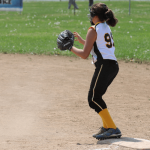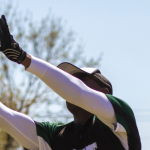*Note: products listed on Bases Loaded Softball are selected by our softball players, coaches, and team of enthusiast writers and editors. Buying softball products through our links may earn us a commission with no additional cost to you.
Every softball position requires a unique set of skills and responsibilities. One position that often goes unnoticed, yet plays a crucial role in the success of the team, is right field. In this comprehensive guide, we will explore the various aspects of mastering the right field position in softball, from understanding its role to elevating your performance.
The Role of Right Field
Right field may not receive as much attention as other positions, but it is far from insignificant. As a player in right field, you serve as a reliable backup for your teammates and play a pivotal role in the overall team strategy.
When you step onto the field as a right fielder, you take on the responsibility of being a reliable backup. This means always being alert and ready to assist your teammates whenever necessary. Whether it’s backing up a throw to third base or covering first base on a bunt, your presence in right field ensures that any potential gaps in defense are covered.
But being a backup in right field goes beyond just covering bases and making throws. It’s about understanding the game situation and anticipating the needs of your team. For example, if the outfield is shifting towards left field due to a left-handed power hitter at the plate, you need to be aware of the potential gaps that may open up in right field and position yourself accordingly. Your ability to read the game and make split-second decisions can greatly impact the outcome of a play.
The Importance of Being a Reliable Backup
Being a backup in right field is not just about being physically present; it’s about being mentally engaged as well. You need to constantly analyze the game, anticipate potential plays, and communicate effectively with your teammates. By doing so, you can ensure that everyone is on the same page and ready to make the necessary plays.
Furthermore, your role as a reliable backup extends beyond the defensive aspect of the game. In the batting order, right fielders often find themselves hitting towards the bottom of the lineup. This means that you have the opportunity to set the table for the top of the order. By getting on base or executing productive outs, you can provide your team with scoring opportunities and contribute to their overall success.
Key Hitters to Watch Out for in Right Field
One of the unique challenges of playing right field is dealing with the batters who are known for their power and accuracy. As a right fielder, you must be prepared to face some of the most formidable hitters in the game.
From the towering home run hitters to the sharp line drive hitters, right fielders encounter a wide range of offensive threats. Developing a keen eye for their tendencies and adjusting your positioning accordingly can make all the difference in preventing extra-base hits. For example, if you notice that a certain batter tends to pull the ball towards right field, you may need to position yourself deeper and closer to the foul line to cut off potential hits.
Additionally, right fielders often have to deal with the pressure of making accurate throws to various bases. With runners on base, you need to be able to quickly assess the situation and make a strong, accurate throw to the appropriate base. This requires not only a strong arm but also the ability to make split-second decisions under pressure.
Playing right field may not always bring the spotlight, but it is a position that requires a unique set of skills and a deep understanding of the game. By being a reliable backup, anticipating plays, and effectively handling key hitters, you can make a significant impact on the success of your team.
back to menu ↑The Challenges of Playing Right Field
Playing right field comes with its own set of challenges, both physical and mental. In this section, we will delve into the skills and techniques that will help you overcome these challenges and excel in this position.
Is Right Field a Position for the Pros?
Contrary to popular belief, right field is not limited to amateur players. Many professional softball players have honed their skills to become exceptional right fielders. The combination of speed, agility, and a strong arm makes right field a position that demands expertise.
Professional right fielders possess an innate ability to read the game and anticipate the actions of opposing players. They are constantly analyzing the field, positioning themselves strategically to maximize their chances of making successful plays. The level of skill required to excel in right field at the professional level is a testament to the position’s significance.
Essential Skills for Success in Right Field
To thrive in right field, you must possess a blend of fundamental softball skills. These include accurate throwing, agile footwork, and the ability to make split-second decisions. Developing these skills will enhance your overall performance and make you a valuable asset to your team.
Accurate throwing is crucial in right field, as it allows you to quickly and efficiently get the ball back to the infield, preventing runners from advancing. In addition, agile footwork enables you to cover ground effectively and make challenging catches, while the ability to make split-second decisions ensures that you react promptly to different game situations.
Furthermore, mastering the art of reading the ball off the bat is essential for right fielders. This skill allows you to anticipate the trajectory of the ball and position yourself accordingly, increasing the likelihood of making successful catches or preventing extra bases.
Improving Catching and Throwing in Right Field
Catching and throwing are fundamental skills that every outfielder must master, and right field is no exception. Practicing fly ball drills and working on your throwing accuracy are essential for better fielding and minimizing the opponent’s advances.
When it comes to catching, right fielders must be proficient in both routine and difficult catches. Routine catches involve tracking the ball from the moment it leaves the bat and positioning yourself to make a comfortable catch. Difficult catches, on the other hand, require exceptional athleticism and hand-eye coordination. By practicing various catching scenarios, such as running catches or catches near the outfield wall, you can improve your overall fielding abilities and catching quickness.
Throwing accuracy is equally important for right fielders. A strong and accurate throw can deter baserunners from advancing or even result in a crucial out. Regularly practicing your throwing mechanics, such as proper arm extension and follow-through, will help you develop a strong and accurate throwing arm.
Enhancing Ball Visibility in Challenging Situations
Visibility can be a significant challenge for right fielders, especially during dusk or under glaring stadium lights. By adopting techniques such as using sunglasses, adjusting your positioning, and utilizing peripheral vision, you can improve your ability to track the ball and make timely plays.
Wearing sunglasses with polarized lenses can reduce glare and enhance visibility, allowing you to better track the ball against the bright sky or stadium lights. Additionally, adjusting your positioning based on the sun’s position can help minimize its impact on your field of vision.
Utilizing your peripheral vision is another effective technique for maintaining ball visibility. By keeping your eyes focused on a specific point while using your peripheral vision to monitor the ball’s movement, you can quickly react to its trajectory without losing sight of it.
Effective Communication in Right Field
Communication is key for any successful team, and right field is no exception. Establishing effective communication with your fellow outfielders and the rest of the team will ensure proper defensive alignments, avoid collisions, and create a cohesive unit on the field.
In right field, communication is particularly important when it comes to relaying cutoff throws and coordinating defensive strategies. Clear and concise communication between outfielders and the infield can prevent miscommunication and errors, ultimately leading to a more solid defense.
Furthermore, maintaining open lines of communication with your teammates fosters a supportive and collaborative environment. By encouraging each other and providing feedback, you can collectively work towards improving your performance as a team.
back to menu ↑Elevating Your Performance in Right Field
In this section, we will explore advanced techniques that will help you elevate your performance in right field and become a standout player.
Perfecting Your Jumping Technique in Right Field
As an outfielder, you will often find yourself in situations that require you to time your jumps perfectly to make those exceptional catches. Learning how to read the ball off the bat and practicing your jumping technique will allow you to make those highlight-reel plays.
Mastering the Art of Diving in Right Field
Diving for a catch is a high-risk, high-reward move that can turn the tide of a game. Properly executing a dive requires practice and a fearless mindset. By honing your diving skills and being willing to give everything for the play, you can become a defensive force in right field.
This video has some great training tips for diving in right field:
Practicing Against the Fence for Right Field Excellence
Right fielders often find themselves making plays near the outfield fence. To excel in this aspect, practicing against the fence can be immensely beneficial. It will help you develop spatial awareness, improve your timing, and build confidence when making plays near the boundary.
Strategic Field Placement in Right Field
Understanding the tendencies of opposing hitters and strategically positioning yourself in right field can make a significant difference in preventing extra-base hits. Analyzing data, studying the batter’s hitting patterns, and adjusting your field placement accordingly will enable you to be proactive in your defensive approach.
back to menu ↑Concluding Thoughts on Playing Right Field in Softball
Mastering the right field position in softball requires a combination of physical prowess, mental acuity, and continuous practice. It is a position that demands versatility, adaptability, and a commitment to excellence. By applying the techniques and strategies discussed in this comprehensive guide, you can elevate your skills in right field and become an invaluable asset to your team.
Image Credit: “Womens Softball vs. Nottingham” by Lawrence Township Public Schools is licensed under CC BY-SA 2.0








